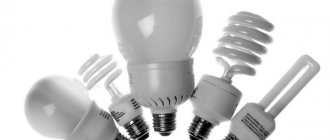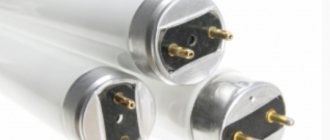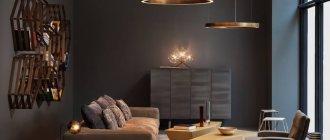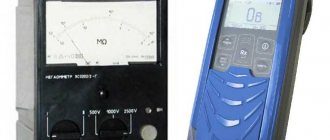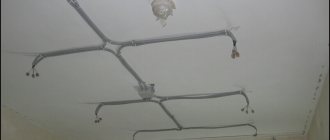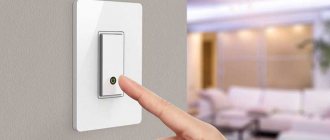Ultraviolet lamps have long been used to treat rooms in medical institutions. Later they began to be called bactericidal and used at home. Devices are often purchased by parents after the birth of a child to protect him from harmful microorganisms.
As interest in UV lamps grew, different types of devices began to appear that met the specific needs of buyers. For example, some devices used in hospitals are not suitable for use at home. You should consider the types of emitters, operating principles and purpose.
What is a UV lamp
An ultraviolet lamp is a device that emits artificial light that has bactericidal properties. The lamp emits part of the spectrum of sunlight - a neon purple glow is formed in the bulb. When the device is connected to the network, the mercury vapor inside the bulb begins to interact with electromagnetic discharges, emitting ultraviolet light.
Fig. 1 – UV irradiator.
Instead of mercury, cadmium, indium or bismuth is sometimes present inside the housing. The light emitted is in the range between X-rays and rays visible to the human eye. The UV lamp has the form of an elongated bulb, along the edges of which electrodes are installed that create a discharge to interact with mercury. Outwardly, it resembles a standard fluorescent lamp.
Mercury-xenon and amalgam lamps
The source of UV rays in the lamp is mercury vapor, but mercury, as you know, is far from the most harmless substance, which is why safer lamps are being developed:
- mercury-xenon (often mistakenly called simply xenon) contain mercury vapor mixed with xenon vapor inside. The lamps have bluish-white radiation with a predominance of UV rays, and are used for ozonation, sterilization, and physiotherapy;
- amalgam lamps have amalgam coating on the bulb; this is an alloy based on mercury, bismuth and indium. When the lamp is turned on, current passes through the alloy, heating occurs, mercury evaporates, which emits UV rays. These are the safest lamps, which, moreover, are characterized by increased durability.
Principle of operation
The operating principle of an ultraviolet lamp is almost identical to a quartz lamp. The main difference is that here, in most cases, special uviol glass is installed instead of quartz. It is necessary to filter aggressive UV radiation. Thanks to this, the device does not emit ozone, but only harmless soft ultraviolet light.
Inside the housing there are molybdenum current-carrying threads and electrodes in mercury vapor. The case is sealed and equipped with a durable base.
Varieties
Among existing UV emitters for disinfection, bactericidal and quartz lamps have become the most popular. In classical instruments, the flask is made of quartz glass. During operation, the device releases harmful ozone into the air.
The main difference between a UV lamp and a quartz lamp is different glasses.
Such devices are more often used for treating medical and industrial premises, where a person does not necessarily need to be present at the time of treatment. A uviol glass flask is installed in the bactericidal emitters. Structurally, ultraviolet lamps are as follows:
- portable . Due to their compactness and light weight, they are widely used in everyday life. Used to treat toilets, tables, sinks and shoes;
- open . Kill pathogenic microbes in the air and on all surfaces. There should be no animals, people or plants in the room when the device is operating. Suitable for processing large spaces;
- closed . They are called closed-type recirculators. They are often used in everyday life, since processing can be carried out in the presence of a person. The lamp design includes a fan. It is necessary to draw air inside, where disinfection with ultraviolet rays occurs. Next, the purified air goes back into the room.
Fig. 3 – closed type lamps.
In addition to design differences, ultraviolet lamps are divided by type of installation. They can be:
- floor . Best suited for disinfecting large spaces. They are often placed in a corner of the living room, hallway, bedroom or nursery. Sometimes used to disinfect wardrobes;
- mounted _ Installed on the ceiling or wall. The lamp must be mounted only on a reliable mount. Thanks to the large number of shapes and colors, the device can be selected taking into account the design of the room. The devices are characterized by increased efficiency;
- desktop _ They usually have a laconic design and small size. Such models can be used in any room, regardless of whether there are people there or not.
Fig. 4 – desktop UV irradiator.
Some models of ultraviolet color lamps are equipped with an automatic connection mechanism. If the disinfectant will be used at home, it is better to choose a portable model.
Rating of bactericidal lamps for 2022.
Recirculator (Armed CH-111-130).
The rating is based on data from specialized online stores of medical equipment. It is informative and not promotional.
As an example, closed-type ultraviolet recirculators for large rooms with a power of 30 W are considered.
- Armed CH-111-130 . Overall dimensions: 10.5x11x50.5 cm. Mounted on the wall.
pros
There is a possibility of installation on a mobile stand. Metal body. Equipped with a light bulb operating indicator.
Minuses
Short power cord. The mobile stand is purchased separately. Price about 7000 rubles
- Ecoquartz 30M. Wall mounted. One light bulb.
Ecoquartz 30M
pros
There is a possibility of installation on a mobile stand. Metal body. Inexpensive (about 3500 rubles). High power of bactericidal air flow. Stylish.
Minuses
There is no timer. The mobile stand is purchased separately.
- MedTeko OBR-15/2-P. Mobile. Two lamps of 12 W each. Overall dimensions: 25x13.2x63 cm.
MedTeko OBR-15/2-P
pros
There is a timer and an indicator of how long the bulbs have been used. Automatic shutdown when the fan stops.
Minuses
The price is higher than previous models (around 8,000 rubles).
- Medigesis MSK-909. Mobile. Overall dimensions: 63x30x13 cm. 2 bulbs of 15 W each.
Medigez MSK-909
pros
Metal body. Convenient and quick replacement of light bulbs. Optimal price (5000-6000 rubles)
Minuses
There are no timers.
- MedTeko OBR-30t. Wall. One working light. Overall dimensions: 90x90x101 cm.
MedTeko OBR-30t
pros
Light bulb operating life indicator. Automatic shutdown when the fan stops. Low price (approximately 4000-5000 rubles).
Minuses
Quite large overall dimensions.
As an alternative to purchasing a device, some manufacturers offer bactericidal light bulbs that can be screwed into a chandelier or sconce. For example, OB-03 “FOTON”. The irradiator kit includes a choke, which allows you to screw the bactericidal lamp into a regular lamp with an E27 socket.
Use disinfection devices correctly and be healthy!
- Related Posts
- Types of lamps and lighting
- How to determine LED polarity
- Lighting of building facades: varieties, principles of organization
Discussion: 8 comments
- Gosha:
I wonder if microbes develop resistance to ultraviolet radiation?Answer
Vampaza:
Unfortunately, I don’t know any microbes that develop resistance to UV rays. But there are various bacteria of spore forms (Bacillus, Paenibacillus), whose resistance to UV is much higher. This may be due to the presence of spores that minimize UV damage. Also, gram-positive (Arthrobacter) and pigmented (Rhodococcus) microorganisms have significant resistance to ultraviolet radiation, in contrast to gram-negative and non-pigmented ones, respectively. Therefore, germicidal lamps protect against 99% of bacteria, and not 100%.
Answer
Are rats and mice afraid of this device?
Answer
- Vampaza:
Hello, Larisa. Ozone lamps emit radiation (poisonous ozone), which is harmful to all living organisms (including rats and mice), but they are unlikely to avoid rodents, a dubious option for repelling. And ozone-free lamps do not harm living organisms.
Answer
Hello, will it protect you from the corona virus?
Answer
- Vampaza:
Hello, Ernar. Germicidal lamps destroy the cellular structure of 99% of bacteria, viruses and other microorganisms. When disinfecting a room or its individual areas, it will undoubtedly help, this virus lives on the surface of a non-living organism for about 10 hours (depending on the surface itself), you can also disinfect clothes, shoes, but there is a risk of things fading. What about protecting the human body from this virus? The lamp is not an assistant in this regard, since it only treats individual surfaces. And ozone-type lamps can actually cause harm.
Answer
A quartz lamp from a Chinese home broke. What to do? Selling an apartment?
Answer
- Vampaza:
Hello, Gennady. You need to find out what type of UV lamp you are using. If these are lamps that do not contain mercury, then simply dispose of the remaining lamps in the trash. If the UV lamp contains mercury, but the source of the glow is not a gas-discharge source, then only the bulb itself is dangerous. Dispose of its fragments properly () and ventilate the room. If the UV lamp has a gas-discharge light source, it is necessary to collect the mercury with a rubber bulb and treat the place where the bulb was broken with a 0.1% solution of potassium permanganate. Dispose of flask fragments and mercury in special containers. And remember, a broken lamp or thermometer does not threaten anyone with deadly diseases.
Answer
Ultraviolet lamp device
The ultraviolet lamp consists of the following elements:
- flask made of uviol or quartz glass;
- tungsten electrodes;
- metal base;
- molybdenum threads;
- coupling (ceramic);
- connector
Fig. 5 – design of an ultraviolet lamp.
What is it for?
Ultraviolet lamps are used:
- for medicinal purposes. For laryngitis, sinusitis, sinusitis, non-purulent otitis media, influenza and tonsillitis. In the midst of an epidemic, ultraviolet lamps are used as a bactericidal agent. Ultraviolet radiation therapy is not recommended for children under 3 years of age. But this is possible if the newborn has a mild form of liver dysfunction (manifested as jaundice). For a runny nose and sore throat, a model with a short wavelength is suitable. Often included are attachments;
- for water purification. The devices look like a tank with a lamp. The disinfector treats the liquid with rays, destroying harmful microbes. The output is clean and usable water. It is important to learn how to determine the amount of ultraviolet light needed for cleaning. In addition, you need to change the lamp when it begins to weaken;
- for plants. When they suffer from a lack of ultraviolet radiation, the issue can be solved with the help of a phytolamp. Artificial radiation will help ensure the process of photosynthesis, which is necessary for full development.
Fig. 6 – device for water purification.
What does ultraviolet lamp kill?
Thanks to ultraviolet rays, the device is able to kill dangerous viruses, bacteria (staphylococci, bacilli, enterococci), fungi (yeast and mold) and mold.
Fig. 7 – microorganisms susceptible to radiation.
The antibacterial effect is explained by the property of short-range ultraviolet rays (up to 280 nm). They are able to penetrate the DNA of pathogenic microorganisms and destroy it from the inside, preventing further reproduction.
Also read: Differences between a recirculator and a quartz lamp.
What options do the lamps have?
Modern manicure lamps have many great additional features. Let's look at the most popular ones.
Timer
The timer is a must-have lamp because it allows you not to track time. You can simply press the button and continue to work calmly with your other hand. Typically, the timer consists of several buttons on the outside of the lamp indicating the time during which the lamp will cure the coating: 10, 30 and 60 seconds.
Display
If the lamp has an auto-on function, then using the display you can track the time during which the coating dries.
Power reduction button
Necessary for masters who receive clients with sensitive nails. Using this button, you can adjust the flow of light and power, thereby reducing heating and reducing pain from burning artificial material.
Motion Sensor
Thanks to the presence of such a sensor, the lamp turns on and starts working when you raise your hand, and not by pressing a button. Convenient and saves time!
Fan
The fan helps cool the internal heating elements when the lamp is used continuously. Please note that the fan does not have the ability to reduce discomfort from burning material!
Removable bottom or no bottom
If you plan to do not only a manicure, but also a pedicure, then pay attention to lamps with a removable bottom or without a bottom at all. Why? For reasons of hygiene, the removable part of the device is easier to disinfect.
Presence or absence of a back wall
It is no secret that when exposed to ultraviolet rays, artificial material polymerizes. Therefore, not all craftsmen are comfortable with lamps without a back wall, since during work, due to carelessness, rays may fall on the bottle of gel polish, which will lead to thickening of the gel polish or the appearance of lumps.
Mirror inner surface of the lamp
The mirror surface increases the amount of light and distributes it evenly.
Autonomous battery and USB
These are relatively new options found in new generation lamps.
The battery allows you to work without connecting to the network, and using USB ports you can charge smartphones and other mobile devices. Choose a lamp that suits you in all respects
How to use a lamp correctly at home
It is believed that ultraviolet radiation, even in minimal quantities, can be harmful to health. When using a disinfection device, you must adhere to safety precautions. Rules for using the disinfectant:
- the bactericidal device should be turned on only if there are no people in the room and only for the period of time specified in the instructions;
- If you need to treat any parts of the body with ultraviolet light, you need to make sure that the device is intended for these purposes. Before turning on, you should put on special glasses (often they are included) and close your eyes. It is also worth adhering to the recommended mode, distance to the lamp and treatment time;
- If a spectrum “C” lamp was used, it is necessary to ventilate the room after the procedure. This is necessary to remove accumulated ozone;
- When using a household recirculator, just in case, you should make sure that it is truly ozone-free. If this is not the case, you cannot turn it on in the presence of people in the room.
Fig. 8 – areas of application of recirculators.
Power
If when choosing most household appliances (heater, boiler, vacuum cleaner, blender) it is recommended to choose a device with a higher power than is necessary in reality (so that the device does not work at its maximum capacity), then with UV lamps the opposite is true. It is better not to exceed the power.
For a room of 20-35 m2, a lamp with a power of 15 W is suitable, for a room of 40 m2 - 30 W.
How long can you stay under the lamp?
To disinfect the room, the device is turned on for approximately 15-30 minutes. Even if it is a harmless ultraviolet lamp, it is better to leave the room while it is working and take plants and animals with you. Upon completion of the procedure, the room must be checked. If a child has signs of acute respiratory infections, the doctor may prescribe treatment with ultraviolet rays.
Fig. 9 – Lamp for treatment “Sun”.
To do this, the child is put on special glasses, seated or placed on a couch (10 centimeters from the device) and the procedure is carried out. It lasts no more than 10 minutes. The general course of treatment is 3-4 days. After 3 sessions, cold symptoms should disappear. When treating the nasal mucosa, it can be irradiated only after the amount of discharge has decreased. Depending on the intensity of symptoms, the daily radiation dose can be reduced to 3 minutes, then to 1.
What to look for when choosing a device
Before purchasing, you should decide on the purpose of purchasing an ultraviolet lamp. At home, low power lamps are used. From photographs of UV lamps you can evaluate whether the lamp will look as harmonious in the interior as in the photo. When purchasing a lamp for a specific application, follow the manufacturer's recommendations. Carefully read the instructions for the device and find out the power, wavelength, and scope of application of the device. Information about the service life and information about the configuration with additional devices and attachments is also important.
Purposes of purchasing a UV lamp
The correct choice of model depends on the accuracy of determining the scope of application of the device. Today, ultraviolet lamps are purchased for use for the following purposes:
table 2
Purposes of using UV lamp
| Purpose of acquisition | Scope of application |
| Changing the physical properties of materials | Dentistry, cosmetology |
| Anti-counterfeit protection, detection of traces of biological fluids | Forensics and criminal law |
| Replenishment of natural ultraviolet deficiency, disinfection | Medicine, in everyday life |
Device mounting method
Equipment with ultraviolet lamps in most cases is available with wall mounting; sometimes ceiling options can be found on sale. In all cases, the device can be placed on the table, ignoring the instructions. However, it is better to trust the choice of a manufacturer that offers a certain type of fastening for stationary high-power models. The device is placed in the selected location and secured if movements are not included in the operating plans. Mobile devices can be installed on the floor or any surface.
UV emitter power
Depending on the size of the room, the power of the device is selected.
For proper use, the instructions for the UV lamp indicate the area of effect of the device. It is generally accepted that for a room with a volume of up to 65 cubic meters. m, a lamp power of 15 W is sufficient with an emission spectrum of 230 nm. If, at a height of 3 m, the area of the room is no more than 35 sq.m., then a lamp with a specified power of 15 W will be sufficient for processing.
Wavelength
The main characteristic of a device with ultraviolet lamps is wavelength:
Table 3
UV lamp wavelength
| Type of radiation | Subgroups of the ultraviolet spectrum range | Ultraviolet range |
| Near | ultraviolet A | long wave range 315–400 nm (UVA) |
| Average | ultraviolet B | mid-wave range 280–315 nm (UVB) |
| Further | ultraviolet C | shortwave range 100–280 nm (UVC) |
| Extreme | letter designation is missing | ultrashort wave range 10–121 nm (XUV) |
Humans can visually perceive near-ultraviolet light due to photoluminescence. The far and extreme ranges are practically inaccessible under natural conditions, since the rays of this spectrum are almost completely absorbed when passing through the layers of the earth's atmosphere.
Life time
The operating life of a UV lamp is usually indicated by the manufacturer in the form of service hours. Depending on the type of lamp, the service life can be from 6,000 to 13,000 hours of operation without a significant reduction in radiation power. The following factors influence the service life:
- temperature of the application environment;
- external conditions during operation;
- number of inclusions;
- rated power of the device;
- lamp location in accordance with the manufacturer's recommendations;
- compliance with operating rules.
UV lamps must not be disposed of in containers with regular household waste. They must be disposed of in a special way, so used lamps are handed over to collection points.
Advantages and disadvantages
Among the advantages of ultraviolet bactericidal lamps, several main ones can be distinguished:
- due to their diversity, the devices can be used in different fields of activity, as well as in everyday life;
- most models last a long time at a low price;
- devices almost instantly reach operating radiation power levels;
- modern recirculators are safe for health; they can be turned on without leaving the room.
Disadvantages include the release of ozone into the air. If you do not follow safety rules, you can harm yourself. In addition, lamps should not be simply thrown away with the rest of the trash. To do this, they are taken to specialized reception points. Also, do not forget that you need to constantly monitor the correct operation of the lamp, gradually it will begin to lose its properties.
Video: Are you sure that you have chosen the right UV lamp for your animal?
Application area
UV lamps have a disinfecting effect, so they are used in medical institutions, kindergartens, sanatoriums and in everyday life. But besides this, ultraviolet radiation has a positive effect on the general condition of the body. With a lack of sunlight, the immune system weakens and the skin turns pale. Therefore, with the help of such a device it is easy to increase the synthesis of vitamin D. And as everyone knows, with the help of vitamin D, the human body better absorbs calcium, which is necessary to maintain healthy bones and teeth. But besides this, ultraviolet light has a general strengthening effect. With its help, the human body will resist the effects of viruses and bacteria, which is especially useful in spring and autumn, when the “cold season” begins.
Ultraviolet lamps have also found their application in cosmetology. Here, such devices are used in solariums, to create an artificial tan, as well as by nail technicians. In the second case, ultraviolet light is capable of polymerizing certain materials. This is how masters apply gel coating and extend nails. Using the same principle, UV lamps are used in dentistry, when the doctor performs tooth extensions.
This device has also found application in forensic science. Using radiation, you can verify the authenticity of valuable documents or banknotes, as well as find blood stains, traces of explosives or poisons.
Do not forget about the use of such lamps for exotic animals. Once in our country, they feel a clear lack of sunlight, which will subsequently lead to illness or death of the pet. By adding an ultraviolet lamp to the terrarium, the owner will compensate for the lack of light and create favorable conditions for the inhabitant.
Life time
On average, bactericidal lamps last 8000-9000 hours. It depends on their purpose and design. The service life depends on whether the emitter overheats during operation or not.
Fig. 10 – service life of UV irradiators.
During operation, the lamp gradually wears out. This is reflected in the radiation spectrum, so over time its properties will begin to change. If deviations in the operation of the device are noticed, it is better to replace it with a new one.

